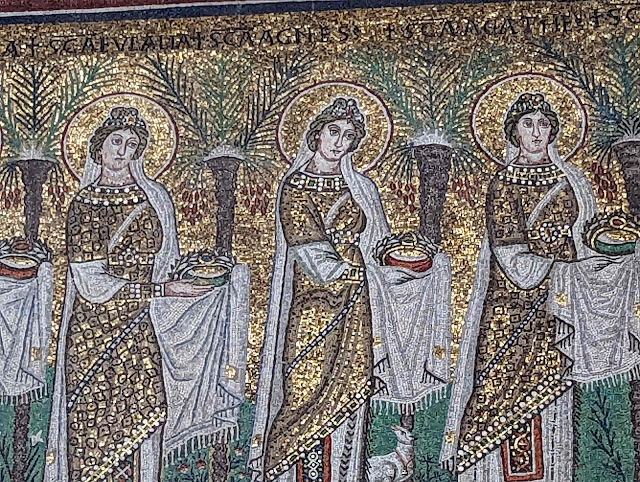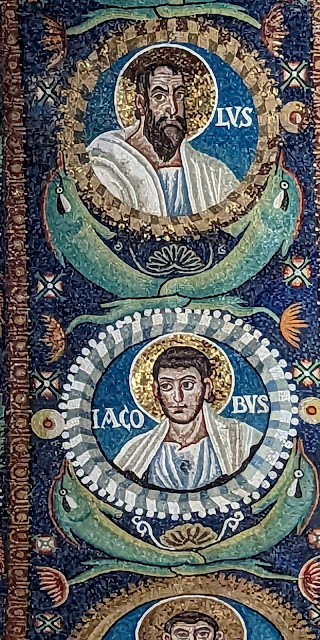I
mentioned that I'd write more about our trip to Ravenna and now I'm going to
try to explain a little about this city's mosaics and history. Three primary
churches in this area (Sant'Apollinare in Classe, San Vitale, and Sant'Apollinare Nuovo) were built during Byzantine times, under the reign of the Ostrogoths, the rulers of Italy in the end of the 400's and beginning of the
500's. The history of the Goths--Visigoths (western) and Ostrogoths (eastern) is sketchy because
they didn't survive to provide a continuous history.
The primary ruler of the Ostrogoths (the prefix Ostro has the same root as
Austria) was Theodoric the Great, whose tomb is in Ravenna; but not his
body—Justinian had it removed when he was in charge. The most important element
about the Goths is that they were Arian Christians who followed the teachings
of Arius (not Aryans, the racial classification celebrated by Nazis and their
philosophical descendants.)
Arians were heretics (according to those who prevailed) because they rejected
primary elements of Trinitarian theology. (I'll write about that in my personal blog for those who
want more information on the subject.)
When the Ostrogoths were driven out of Italy and into *oblivion,* (which evidently lies to the north) these Gothic structures fell into the hands of the Catholics who preserved their marvelous artwork; which in turn preserved remnants of their ancient theology.
Margaret Barker, a British Bible scholar, author, Methodist, and theologian
included a scene from one of these mosaics on the cover of her book, Temple
Theology. Though her photo only includes the right half of the scene
below, she felt that it displays elements of early Christian theology regarding
the temple.
Her books point out temple themes that have been lost in most of today's Christian theology but that have been retained in the New Testament and in ancient architecture. For example, she notes that the existence of altars in every Christian chapel demonstrates that Christian chapels were an attempt to replicate the temple rather than the Jewish synagogue. No synagogue ever had an altar, which since the time of the Babylonian captivity and until Christian times, had been exclusive to the temple.
Back to Ravenna specifically, it was under the rule of the Ostrogoths until emperor Justinian's forces conquered them in 562 at a cost (according to Wikipedia) to the Byzantine Empire of 300,000 pounds of gold and the lives of 15,000,000 Ostrogoths. As a result of Justinian’s victory, some of the mosaics in the three byzantine cathedrals were modified to replace Theodoric’s image with that of Justinian and members of his court. Other mosaics show signs of incomplete modifications. Consider a close up from one from the newest of the three cathedrals, Sant'Apollinare Nuovo:
Notice that in the
black area above the curtains, there used to be images that have now been
scrubbed. Some think that the hands coming out from behind the curtains reflect evidence of attempts to scrub images; but it's clear that
the hands are supposed to be in the mosaics because the curtain on the one on the right is draped around the forearm. A larger view of the scene shows more hands
and perhaps an idea of what might have been erased from these panels--perhaps
the work involved to remove these items proved to be too costly for the expected
result. The fourth and sixth curtains have floating crowns above the curtains, and perhaps this is what was removed from the three arches on each end of the scene.
Look at the hands coming from behind the
curtains at (counting from left to right) 1, 3, 4, and 9; and the
evidence of scrubbed images is only at 1, 2, 3, 4, 7, 8, and 9.
Looking at the main curtain in the center of the scene, there are decorations on the curtain that are also present on the altar in the scene of Melchizedec in the church of San Vitale:
Notice also that these right-angle designs are on the curtain, the altar cloth on top of the altar, on the front of the altar, and on the altar itself (in gold.)
The same design is on the curtain behind Melchizedec in the oldest church--Sant'Apollinare in Classe, and on the clothing of men dressed in white in Sant'Apollinare Nuovo. The marks in the curtains are harder to see in this photo because there was a light stand on the right of the image--but the design is again repeated on the altar and on the curtain behind Melchizedec:
In this photo, the same marks are on the curtain. They are in each corner of the curtain but since it's drawn open, the marks at the bottom are obscured.
As you enter the church of Sant'Apollinare Nuovo inside Ravenna (as opposed to Sant'Apollinare in Classe just outside of town), the main area facing the chapel and altar has men on the right, and women on the left. Each is holding a royal crown. I'll discuss that element later, but a view of the men and women standing on each side of the chapel is also interesting.One other item about these churches interests me greatly: There are no crucifixion scenes in any of the artwork; and every depiction of the Savior (except one as an infant in Mary's arms portraying the visit of the wise men) is as a resurrected personage. I have heard varying opinions--some have said that due to the plague in the middle ages, the emphasis in Catholicism changed from victory over death to that of suffering, and since the artwork in these churches antedated the black death, the idea of overwhelming suffering and sadness had not yet taken hold.
From my perspective, these mosaics of the prophets and apostles have the same function as photos and paintings that we have in our meetinghouses and temples.
This mosaic has the bearded Savior holding a book, just as the other depiction of the clean shaven Lord of the universe has a book in his left hand.





6.jpg)














